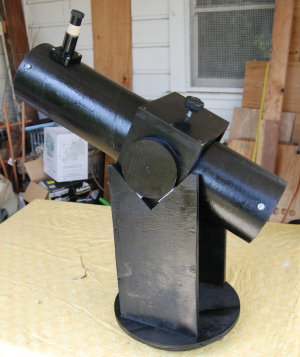Introduction
Making a 4.25 Inch Dobsonian
Reflector Telescope

Reasoning
In 2010 I took a telescope making
class at the Randall Museum. In that
class I attempted to make a 12.5 inch telescope. This attempt failed. The
most notable part of this failure was in breaking John Dobson's cardinal rule,
namely if you are going to break your mirror, do it early. I regrouped and decided to start small.
Now having finished this scope, I
believe it was the correct decision.
Along the way I've heard a number of arguments against this
approach. The most notable one goes
like this; you are probably only going
to make one scope, so make it as big as you can imagine. From my perspective, this approach has a
number of flaws. To begin with,
making a telescope requires a number of skills. These all may be developed as you proceed, but as with most
things in life, you learn by making mistakes.
In the case of a telescope, any of these mistakes can cause you to
create an inferior device, or in the worst case, ruin the project
entirely. In addition, a larger scope
can take a long time to finish. I
can't think of anything more disappointing than spending 6 months to a year
grinding and polishing and figuring a mirror, and then ending up with poor
optics.
On the other hand, grinding and
polishing a 4.25 inch mirror goes very quickly. It went so quickly for me, that when I discovered during the
polishing phase that I had gone through my grits too quickly, it was no big
deal to go back and do the entire fine grinding again. Over the course of three weeks I probably
spent at most 16 hours doing the mirror, and that includes both passes.
But the mirror is only half the
project. There are a number of other
things you will need to construct to make a telescope. Some or all of these my be purchased. But even knowing which items to buy and
which to build is helped by experience.
Working on a smaller scope gave me the time to at least attempt all the
components. In the end I opted for a
purchased secondary and eyepiece, but not before building my own.
A
Caution
I suggest that you do not attempt to build
a telescope if your goal is to save money.
While it is possible, I think it is rather unlikely. You would be better off scanning eBay and
Craig's list for a bargain. The
reason to build your own telescope is because you want to learn how. This is a singularly rewarding experience,
but it is quite unrelated to the quest of looking through it at the
heavens. To use a scope you need your
eyes, a good location, often some warm clothing and an interest in what you are
looking at. To build a scope you need
patience, elbow grease, some carpentry skills and a love for figuring things
out. There will be a lot of figuring
things out. Much of my work was done
at Tech Shop in San Francisco, where I was
able to use their wood shop and milling machines.